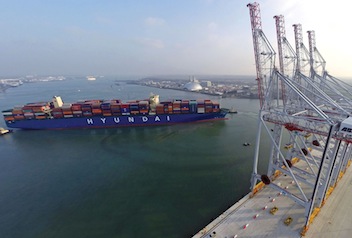The following is the text of a blog by Transportation Secretary Anthony Foxx:
(WASHINGTON) — I’ve traveled all over the country talking with folks about how we find ourselves at a critical moment in our nation’s transportation history. In the next 30 years, our nation will need to accommodate 70 million more people and a 45 percent increase in freight. This growth will especially increase demands on our ports and waterways — which are integral to our nation’s economic well-being and security.
So I was pleased that today (April 6), while at the American Association of Port Authorities spring meeting, I was able to address maritime professionals and experts who are intimately engaged with the challenges ahead of us, and also aware of the opportunity for growth and greater economic prosperity.
This looming population growth, while also affecting our freight patterns and freight flows, will have a spillover effect on our roads and highways. It doesn’t take much to see that the vitality of our roads and ports are interconnected. We need to be able to move the goods to and from our ports. Our ports must modernize — and expand — to remain viable in this intensely competitive, international shipping environment. And federal resources are an available tool to help close the gap that is growing.
Since 2009, more than a half billion dollars in TIGER grants have been invested in 43 port projects across 24 states. Over the seven TIGER rounds of funding, ports have accounted for about 8 percent of the applications, but have received more than 11 percent of the awards. The Build America Transportation Investment Center (BATIC) is working with ports to improve and streamline applications for the department’s credit assistance programs such as TIFIA and RRIF.
Thanks to new transportation legislation in the FAST Act, the Department is able to make $4.5 billion available over the next five years through the FASTLANE grant program. In fact, applications for the first round of $800 million in available funding are due next week. Not to mention the National Highway Freight Program which, over the next five years, will add $6.3 billion in formula funding that port authorities can access by working with their metropolitan planning organizations (MPOs) and state departments of transportation.
It is clear, our nation will drastically change and we’re taking it seriously. History has shown that ports across the country have, and can, spur regional economic growth. As we go forward in modernizing our transportation infrastructure we must challenge ourselves to be thoughtful and inclusive with our design. Projects must aim to simultaneously improve our infrastructure and economy, foster innovation and create access to opportunity.
The steps we take today will serve us in the very near future, as we work together to build the kind of modern, 21st century transportation system that our country needs.

